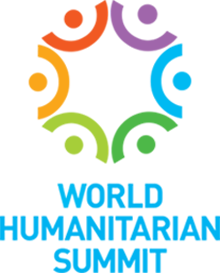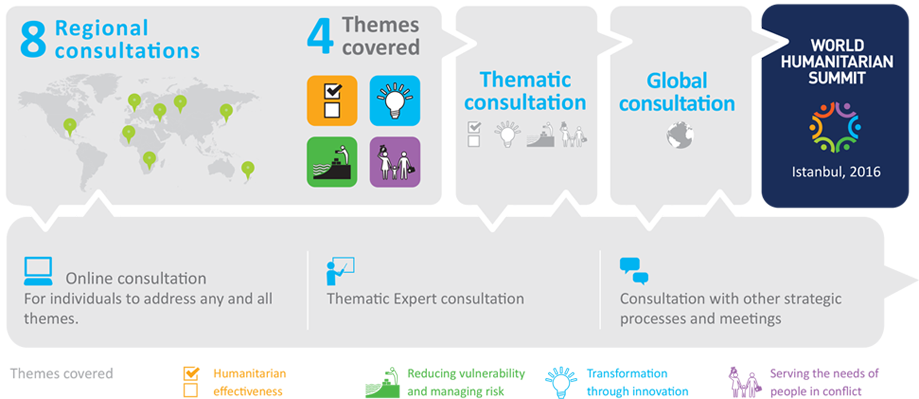World Humanitarian Summit
 We are witnessing the highest level of human suffering since the Second World War. This is why the former United Nations Secretary-General Ban Ki-moon convened the first-ever World Humanitarian Summit to generate commitments to reduce suffering and deliver better for people caught in humanitarian crises, and to demonstrate support for a new Agenda for Humanity. The Summit took place in Istanbul on 23-24 May 2016. It brought together 9,000 participants representing 180 Member States, including 55 Heads of State and Government, hundreds of civil society and non-governmental organizations, and partners including the private sector and academia. Together, they generated more than 3,500 commitments to action and launched more than a dozen new partnerships and initiatives to turn the Agenda for Humanity into meaningful change for the world's most vulnerable people. The Platform for Action, Commitments and Transformation was created to host these commitments and as a hub to track progress and change beyond the WHS.
We are witnessing the highest level of human suffering since the Second World War. This is why the former United Nations Secretary-General Ban Ki-moon convened the first-ever World Humanitarian Summit to generate commitments to reduce suffering and deliver better for people caught in humanitarian crises, and to demonstrate support for a new Agenda for Humanity. The Summit took place in Istanbul on 23-24 May 2016. It brought together 9,000 participants representing 180 Member States, including 55 Heads of State and Government, hundreds of civil society and non-governmental organizations, and partners including the private sector and academia. Together, they generated more than 3,500 commitments to action and launched more than a dozen new partnerships and initiatives to turn the Agenda for Humanity into meaningful change for the world's most vulnerable people. The Platform for Action, Commitments and Transformation was created to host these commitments and as a hub to track progress and change beyond the WHS.

UN Secretary-General
Antonio Guterres
Key Documents
World Humanitarian Summit - Consultation Scheme

FAQ
-
Why and when was the PACT archived?The Report of the Secretary-General on the outcomes of the World Humanitarian Summit (A/71/353) established the online Platform for Actions, Commitments and Transformations (PACT) for a period of three to five years. 2019 – the third year of reporting since the Summit – was the final year of self-reporting and the 2019 Annual Synthesis Report became the final report in the ‘series’. No further reporting on commitments made during the Summit is expected this year or in future. With the conclusion of the self-reflectin process, the PACT was transitioned into an online archive. The PACT will continue to be public, housing all the data and reporting on commitments as well as material from the World Humanitarian Summit.
-
With the PACT archived, is it still possible to edit/delete/add commitments?Unfortunately, it is on longer possible to edit/delete/add commitments. The information in the PACT reflects stakeholders' commitments as of February 2020.
-
What was the World Humanitarian Summit ?
The first-ever World Humanitarian Summit, which took place in Istanbul on 23-24 May 2016, was a global call to action by former United Nations Secretary-General Ban Ki-moon.
The Summit had three main goals:
- To re-inspire and reinvigorate a commitment to humanity and to the universality of humanitarian principles.
- To initiate a set of concrete actions and commitments aimed at enabling countries and communities to better prepare for and respond to crises, and be resilient to shocks.
- To share best practices which can help save lives around the world, put affected people at the center of humanitarian action, and alleviate suffering.
-
What were the Summit's outcomes ?
The World Humanitarian Summit was a pivotal moment for the global humanitarian agenda. It generated global momentum and political determination to move forward on the former UN Secretary-General’s Agenda for Humanity and its five core responsibilities, in order to deliver better for people across the globe. The diversity of voices heard at the Summit, and their convergence around key issues and ideas, was a first for the humanitarian sector.
The Summit generated over 3,000 commitments to action, and over 2,500 alignments with the core commitments to deliver the Agenda for Humanity. In addition, more than 20 initiatives were either launched or strengthened, aimed at improving the lives of people affected by humanitarian crises.
The outcome documents of the World Humanitarian Summit are available here (resources).
-
What issues were discussed at the Summit ?
At the Summit, global leaders discussed how to effectively respond to major humanitarian challenges, and how to be better prepared to meet challenges of the future. Some of the priority issues included:
- A new global approach to manage forced displacement, with an emphasis on ensuring hope and dignity for refugees or internally displaced people, and support of host countries and communities.
- Empowering women and girls, and catalysing action to gender equality.
- Adapting new approaches to respond to protracted crises and recurrent disasters, reduce vulnerability, and manage risk, by bridging the divide between development and humanitarian partners.
- Securing adequate and predictable finance to save lives and alleviate suffering.
- Reinforcing the centrality of protection in humanitarian action and increasing respect for International Humanitarian Law.
- Adapting to new challenges through local, inclusive, and context specific responses.
-
Who attended the Summit ?
The Summit included approximately 9,000 participants from 173 Member States of the United Nations, including 55 Heads of State and Government.
700 NGOs including 350 national and local NGOs and CSOs, and 250 international NGOs and 350 representatives of the private sector were present.
130 representatives of the United Nations agencies, funds and programmes and other stakeholders including academia, faith-based leaders, media and others also participated in the first-ever World Humanitarian Summit.





